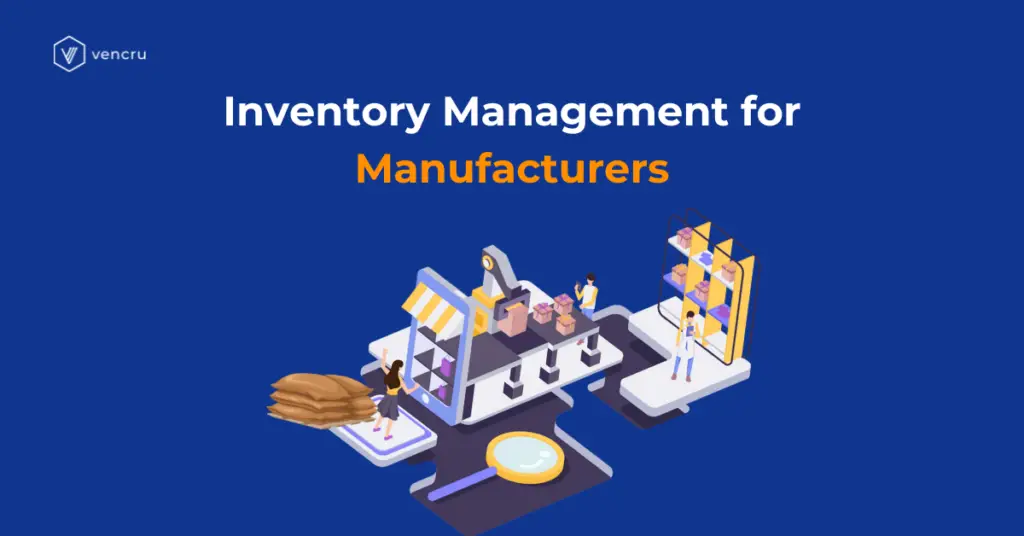Inventory management involves tracking and managing a company’s inventory, including raw materials, work-in-progress (WIP), cost of goods sold, and finished goods. Effective inventory management ensures that a company has the right amount of inventory at the right time, minimizing costs and maximizing efficiency. It is a critical component of supply chain management and directly impacts production continuity, manufacturing cost control, and customer satisfaction. Understanding inventory management is crucial for several reasons. One reason is for calculating work in progress. Another reason is for determining the cost of goods sold. Additionally, it is important for managing material, overhead, and labor costs.
In this blog, we will discuss ways to balance raw materials and production needs, emphasizing the importance of good material management. We’ll be discussing:
- Why Inventory Management Matters for Manufacturers
- Key Challenges in Inventory Management for Manufacturers
- Types of Inventory Manufacturers Should Track
- Strategy for Balancing Raw Materials and Production Needs
- Leveraging Vencru for Efficient Inventory Management
Why Inventory Management Matters for Manufacturers

Inventory management is essential for manufacturers for several reasons:
- Cost Efficiency: Proper management reduces storage costs, waste, and the need for emergency purchases. By keeping production costs, producers can improve their profit margins.
- Production Continuity: Ensuring the availability of raw materials prevents production delays and keeps operations running smoothly. Having sufficient inventory on hand means your production line can continue without interruption.
- Quality Control: Timely production and delivery of products enhance customer satisfaction and loyalty. Reliable material management ensures that customer orders are fulfilled accurately and on time.
- Customer Satisfaction: Timely production and delivery of products enhance customer satisfaction and loyalty. Reliable inventory management ensures that customer orders are fulfilled accurately and on time.
Key Challenges in Inventory Management for Manufacturers
Manufacturers face unique challenges in inventory management:
- Demand Variability: Fluctuating customer demand can make it difficult to predict inventory needs accurately. This variability necessitates precise inventory analysis and effective use of inventory data to anticipate market trends.
- Supply Chain Disruptions: Delays or disruptions in the supply chain can impact the availability of raw materials. Effective inventory reporting and maintaining a robust purchase order system can mitigate some of these issues.
- Storage Constraints: Limited storage space requires efficient use of available space and careful planning of inventory levels. Inventory management systems can help optimize space and reduce overhead costs.
- Complex Production Processes: Managing inventory for complex production processes involving multiple raw materials and WIP inventory can be challenging. Accurate inventory accounting and tracking are crucial to ensure a smooth production line and avoid bottlenecks.
- Manufacturing Overheads: Costs associated with manufacturing overheads, such as indirect labor and other overhead costs, need to be accounted for to maintain accurate financial reports and understand the true cost of production.
- Excess Inventory: Excess inventory can tie up capital and increase storage costs. Manufacturers need to balance inventory on hand to avoid overstocking and understocking, which can affect profit margins.
Related Read: What is Inventory Tracking? Methods, Challenges, & Systems
Types of Inventory Manufacturers Should Track
Manufacturers need to track several types of inventory to ensure efficient production and supply chain operations. These include:
Raw Materials
Raw materials are the basic components used to create products. Tracking raw materials inventory ensures that manufacturers always have the necessary inputs to meet production demands.
Work-in-Progress (WIP)

WIP inventory includes items in various stages of the production process but not yet completed. Monitoring WIP inventory helps manufacturers manage production schedules and optimize workflow.
Finished Goods
Finished goods are completed products ready for sale or distribution. Keeping track of finished goods inventory and cost of goods sold is essential for meeting customer demand and managing storage space effectively.
Maintenance, Repair, and Operations (MRO) Inventory

MRO inventory includes supplies used for maintaining and repairing production equipment. Properly managing MRO inventory helps minimize downtime and ensures that production equipment is always in good working condition.
Safety Stock
Safety stock is additional inventory kept on hand to prevent stock shortages due to an unexpected high demand or supply chain problems. Maintaining an appropriate safety stock level helps manufacturers avoid production delays and meet customer orders on time.
Strategies for Balancing Raw Materials and Production Needs

Here are some strategies manufacturers can use to balance raw materials and production needs effectively:
1. Implement Just-in-Time (JIT) Inventory
JIT inventory minimizes the amount of raw materials on hand by ordering only when needed for production. This approach reduces storage costs and minimizes waste but requires reliable suppliers and accurate demand forecasting.
2. Use Material Requirements Planning (MRP)
MRP systems help manufacturers plan production and inventory needs based on sales forecasts, production schedules, and lead times. MRP ensures that raw materials are available when needed and helps avoid overstocking or stockouts.
3. Conduct Regular Inventory Audits
Regular inventory audits help ensure accurate inventory records and identify discrepancies. Audits can prevent stockouts, overstocking, and waste by keeping inventory levels accurate and up to date.
4. Optimize Supplier Relationships
Building strong relationships with suppliers ensures timely deliveries and better pricing. Regularly evaluate supplier performance and negotiate favorable terms to improve the reliability and cost-effectiveness of your supply chain.
5. Utilize Technology

Leverage technology to streamline inventory management processes. Inventory management software like Vencru provides real-time tracking, automated reordering, and comprehensive reporting, making balancing raw materials and production needs easier.
Related Read: Inventory Management Best Practices
Inventory Management Formulas for Manufacturers
Manufacturers can use several formulas to manage inventory effectively:
Work in Progress (WIP)
This formula calculates the value of unfinished goods in production.
WIP = (Beginning WIP Inventory + Manufacturing Costs) – Cost of Goods Manufactured
Effective inventory analysis is crucial for keeping track of work in progress. Manufacturers can improve production by knowing what WIP inventory is. This helps them avoid investing too much money in unfinished products. Regular inventory reporting and accurate inventory accounting are essential to maintaining an efficient workflow.
Economic Order Quantity (EOQ)
EOQ helps determine the optimal order quantity that minimizes total inventory costs, including ordering and holding costs.
EOQ = √(2DS / H)
Where:
- D = Demand rate (units per period)
- S = Ordering cost per order
- H = Holding cost per unit per period
Using the EOQ formula allows manufacturers to balance inventory on hand with production needs, thereby reducing excess inventory and minimizing overhead costs. This balance is vital for maintaining healthy profit margins and optimizing production costs.
Reorder Point (ROP)
ROP indicates when to reorder inventory to avoid stockouts.
ROP = (Lead Time × Average Demand) + Safety Stock
Accurate calculation of the reorder point is critical for ensuring that the production process runs smoothly without interruptions. Effective inventory tracking and timely purchase orders can prevent production delays and reduce manufacturing costs associated with emergency restocking.
Inventory Turnover Ratio
This ratio measures how often inventory is sold and replaced over a period.
Inventory Turnover Ratio = Cost of Goods Sold (COGS)
A high inventory turnover ratio indicates efficient inventory management and strong sales performance. Regularly analyzing this ratio helps a production company adjust its inventory strategy to meet market demand and maintain optimal levels of finished product
Days Sales of Inventory (DSI)
Days Sales of Inventory (DSI) shows how many days it takes for a company to sell all its inventory.
DSI = (Ending Inventory / Cost of Goods Sold ) * 365
This metric measures the efficiency of inventory management. A lower DSI is generally preferred as it shows that inventory is being sold quickly. A higher DSI may indicate that inventory is not moving as fast, which can negatively impact profit margins and financial reports.
Leveraging Vencru for Efficient Inventory Management
Vencru offers a comprehensive inventory management solution tailored for manufacturers. Here’s how Vencru can help you balance raw materials and production needs:
- Real-Time Inventory Tracking: Track your inventory in real-time with Vencru. Get instant updates on inventory levels to accurately monitor raw materials and production needs.
- Detailed Reports: Generate detailed reports on inventory movements, production schedules, and demand forecasts to make informed decisions. These reports assist in inventory accounting and understanding the true costs involved, including labor costs and manufacturing overheads.
- Supplier Management: Keep track of supplier performance and streamline procurement processes to ensure reliable and cost-effective supply chains. Effective supplier management is key to maintaining a consistent production line and minimizing disruptions.
- Easy-to-use Interface: Vencru makes inventory management simple by helping track raw materials, work in progress, and production needs. This ease of use is beneficial for generating accurate financial reports and ensuring efficient material management.
Related Read: 10 Inventory Software for Wholesale Distributors
Conclusion
Effective inventory management is crucial for manufacturers to balance raw materials and production needs. Manufacturers can improve their inventory processes by using strategies like JIT, MRP, and regular audits. This can help them cut costs and keep production running smoothly. Technology like Vencru can also be used to enhance these processes.
Ready to take control of your inventory and support your manufacturing success? Explore Vencru here or book a demo.
Related Content






